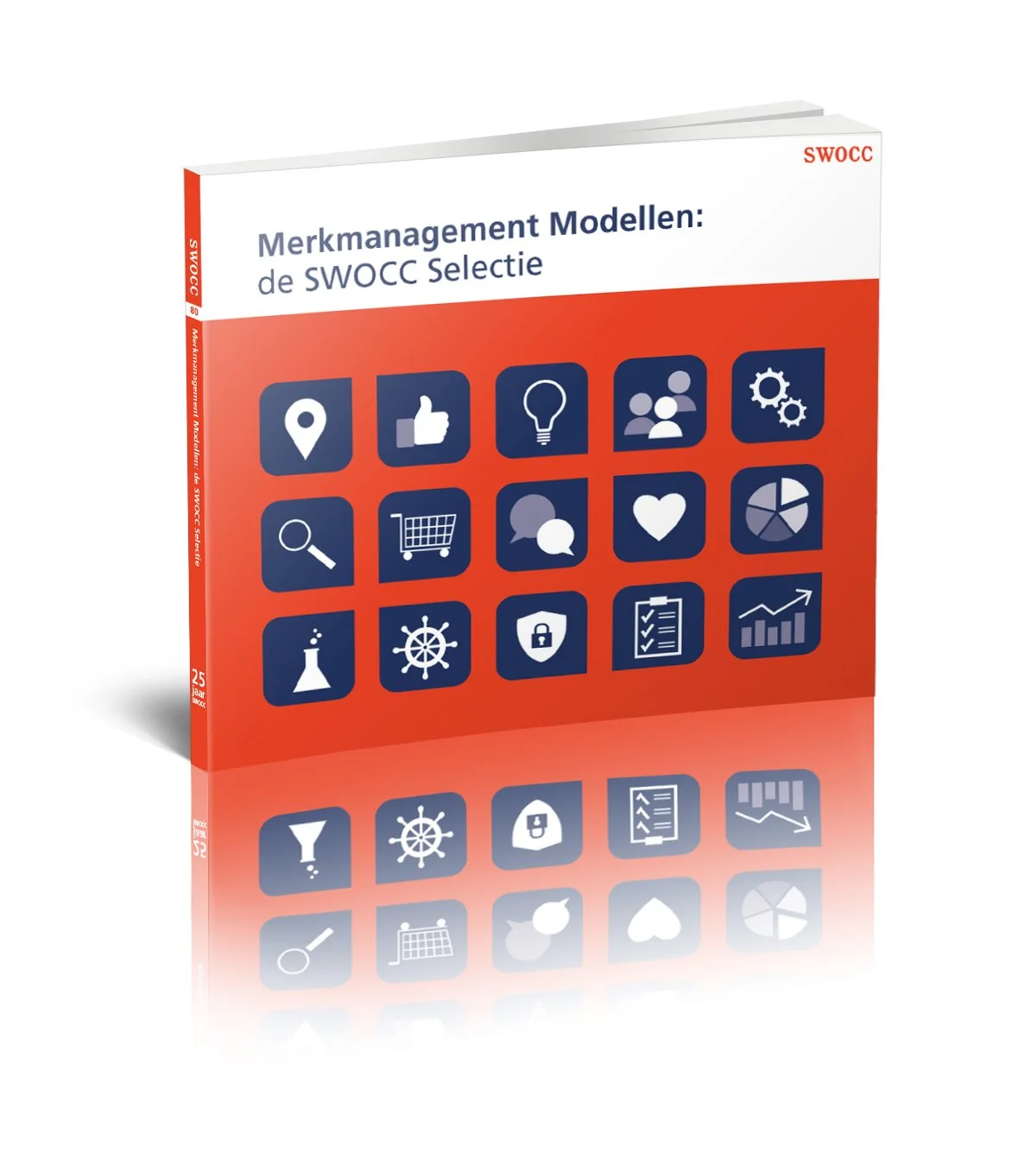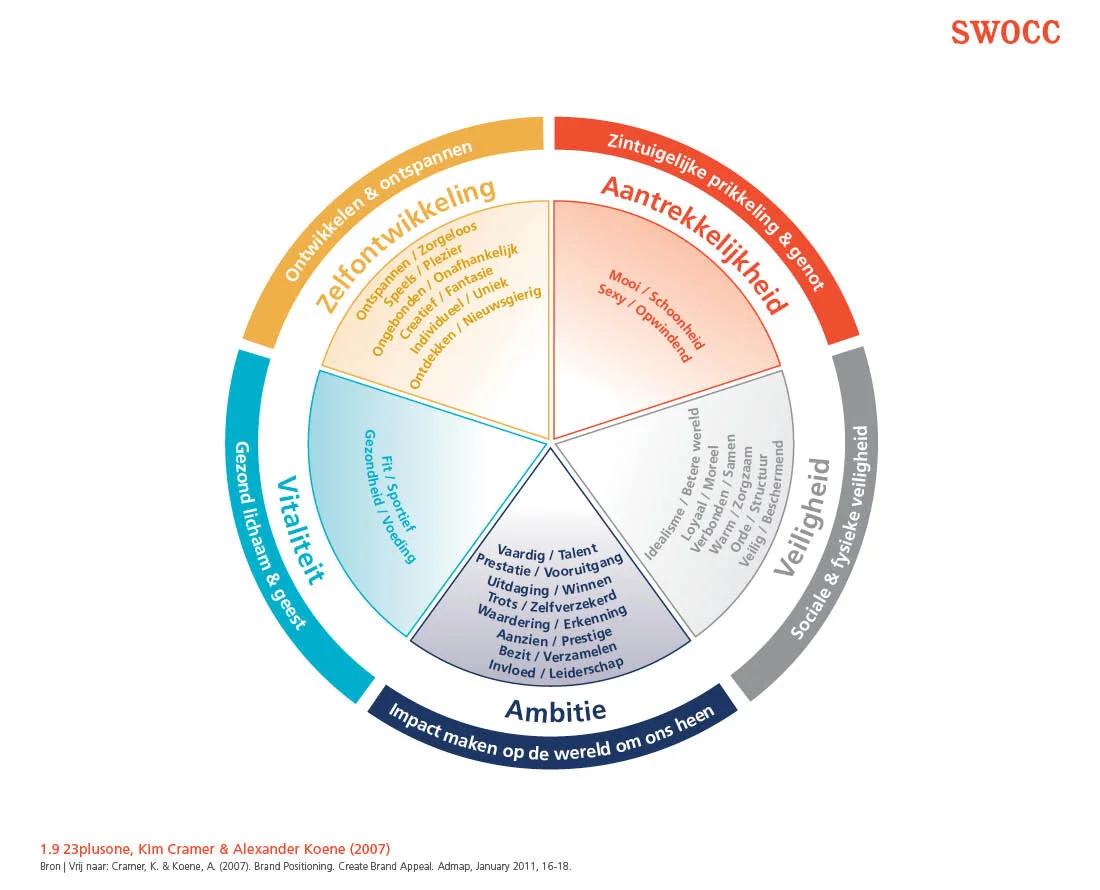SWOCC Book of Brand Management models
How do you create an emotionally appealing brand with a grounded approach?
23plusone included in SWOCC
Book of Brand Management models
For the second time in its 20-year history, the Foundation for Scientific Research in Commercial Communication (SWOCC), affiliated to the University of Amsterdam, publishes the models reference book: Brand Management Models: The SWOCC Selection. As developers of 23plusone, we are proud that the model we use every day to connect brands with people for our clients has been included in this scientific standard work for every brand strategist.
Visual method
The 23plusone method stems from scientific research about the link between what makes people happy and the attractiveness of organisations and brands. Twenty-four universal emotional drivers, clustered in 5 domains (Safety, Self-development, Ambition, Vitality and Attraction) subconsciously guide our behaviour. The method uncovers the individual and collective drives of employees, customers and other stakeholders through physical and online tools. It enables people to connect on the things that really matter in life. In doing so, business and branding become more human, more attractive and better for society and the planet.
Everyone can contribute
BR-ND People developed the method in 2006 based on scientific research aimed at understanding more about the feelings people experience with brands. Because it is a low-threshold, playful method, everyone can contribute to the culture and brand strategy. This creates rich brand stories that are attractive to customers, (future) employees and other stakeholders and leads to growth in the broadest sense of the word. Since 2012, we have also enabled other professionals to help their clients create beautiful, attractive brands and cultures.
In the Netherlands, Malaysia and South Africa, more than 50 licensed professionals work with the method, in the application areas of organisational development, marketing, branding, innovation, communication and coaching. Together, this group forms a community that inspires, learns from and collaborates with each other.
About SWOCC
With practical relevance as a starting point, SWOCC gathers and develops scientific knowledge on how brands and communication work. This enables marketing and communication professionals to keep up with and apply new knowledge in our field. SWOCC's activities are made financially possible by donations from commercial and non-profit organisations. SWOCC is affiliated with the University of Amsterdam.
The text below is taken in its entirety from SWOCC's model book
CHALLENGE
How can the brand connect to people's emotional drives?
SOLUTION
Besides rational variables that contribute to brand attractiveness, such as familiarity and product quality, feelings play an important role. With this starting point, Kim Cramer and Alexander Koene conducted research asking "Why is it that some brands feel so good?". At the encouragement of psychologist Nico Frijda and based on a variety of values, interests and motivation studies (e.g. Reiss, 2000; Oppenhuisen, 2000), Cramer and Koene identified twenty-four emotional drivers. These drives are universal and guide human behaviour. As it proved difficult to give unambiguous meaning to the drives through words, a validated set of visual-verbal stimuli was developed. Physical or digital 'cards', each containing 4 pictures and 2 words, serve to explore the emotional drives of internal and external stakeholders and to engage in dialogue about them, in order to develop brand positioning based on the aspects that are important in human life.
USE CASE
When more emotional drives are triggered by a brand, it appears to feel good and the brand comes across as more attractive than when few drives are triggered. The twenty-four drives are divided into five clusters: safety, self-development, ambition, vitality and appeal. The more clusters a brand triggers, the more attractive the brand is. "The more, the better" does not mean that there are no choices to be made. The desired emotional drivers ("how do we want our brand to feel?") need to match the culture of the people who ultimately are the brand.
In the creative phase of building the brand positioning, 23plusone creates a triangle (Trinity) in which brand pillars are defined based on the drives. They are written out into paragraphs of the brand story. When choosing the drivers for the Trinity, the following laws can be taken into account:
The most attractive brands appeal to many emotional drivers.
The most attractive brands appeal to many clusters of drives.
The 'vitality' and 'appeal' clusters have the greatest impact on brand attractiveness.
The most attractive brands appeal to unexpected drives.
Six drives clearly profile the most attractive brands.
The Trinity forms the basis of the Brand Heart, a one-pager, in which the brand culture, visual and verbal brand expression and stakeholder relationships are hinted at in connection with the (transformation of the) business strategy.
PRACTICE
The emotional charge of a brand is often only filled in at the end of a rational analysis process of the market, organisational strategy, core competencies and distinctiveness. At 23plusone, emotional drivers are used precisely as a starting point. When it is important that the meaning of the brand creates a connection between people, such as in mergers and rebranding of organisations in transition, the method can be used because internal branding can be started even before the brand strategy is defined.
APPENDIX
There are several theories and models on values and motivations that have become famous in the brand landscape and provide guidance for brand positioning, such as from Maslow, Mark and Pearson and the value systems of Hofstede and Schwartz. Such models attach great significance to values and drives. With 23plusone as a so-called emotive branding method, Cramer and Koene moved away from the essence thinking in brand positioning as in Bulls Eye and Brand Key models and instead embraced the potential emotional richness of the brand story (compare Lafferty, 2001 and Akgün et al., 2013). This richness combined with the 'soft' image of feelings is more difficult to manage than rational KPI's, making the method less suitable when there is a need for quick, hard results from brand activation.
SOURCES
Akgün, A. E., Koçoğlu, İ., & İmamoğlu, S. Z. (2013). An emerging consumer experience: Emotional branding. Procedia-Social and Behavioral Sciences, 99, 503-508.
Cramer, K. & Koene, A. (2007). Brand Positioning. Create Brand Appeal. Admap, January 2011, 16-18.
Lafferty, B.A. (2001). Emotional branding: The new paradigm for connecting brands to people. Journal of Product & Brand Management, 10(7), 466-469.
Oppenhuisen, J. (2000). Een schaap in de bus? Een onderzoek naar waarden van de Nederlander. Amsterdam: SWOCC.
Reiss, S. (2000) Who am I: The 16 basic desires that motivate our actions and define our personalities. New York: Tarcher/Putnam.



